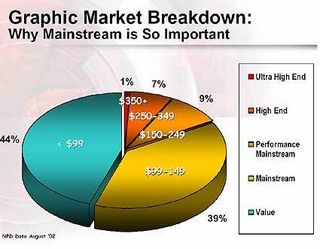VGA Card Buyer's Guide 07/2003
The Price Categories
Graphics cards can be roughly divided into three price ranges, each of which can again be further subdivided into two price segments. The edges between these classes are blurred, though, due in large part to fluctuations in market prices. The two big players in the 3D graphics field, ATi and NVIDIA, offer various versions of their chips in the different price classes. Again, there are two variations of each of these chips, a standard version and a faster one with higher clockspeeds and improved performance. ATi denotes chips of this second category with a "PRO" added onto the name, while NVIDIA uses "Ultra."
The two companies follow differing market strategies as well. NVIDIA concentrates completely on developing and producing graphics chips and does not manufacture or sell its own cards. ATi, on the other hand, does sell its own line of cards ("Built by ATi"), albeit only in the US and Canada. Additionally, partner companies also sell products based on ATi's chips ("Powered by ATi").

Another factor that makes it even more difficult to divide cards into price categories has to do with the older-generation cards, which seem to be getting cheaper every day. In this article, we'll only look at the "youngest" last-generation cards. There are especially pronounced differences between ATi and NVIDIA products here. ATi's last generation (Radeon 9500 and 9700), for example, can still be considered up to date, feature-wise (DirectX 9 and multi sampling FSAA). The Radeon 9000 and the newer 9200, which are based on the Radeon 8500 design and therefore only support DirectX 8 and use the slower super sampling FSAA technique, are the notable exceptions.
From a technological aspect, NVIDIA's last-gen cards are outdated: while the GeForce4 Ti already employs multi sampling FSAA, it only supports DirectX 8, and the GeForce4 MX is a remnant of the DirectX 7 era and still uses super sampling FSAA. Nonetheless, a GeForce4 Ti4200 is still able to outperform an FX 5600 in some games, since it has more pixel pipelines at its disposal.
At the bottom end of the graphics card spectrum you'll find the low budget cards, which we've divided into price segments of either under $100 or between $100 and $150. Typical representatives of this entry-level card segment are often based on ATi's Radeon 9200 or NVIDIA's FX 5200. In the price range of up to $150, we also find PRO and Ultra versions of these chips and a few Radeon 9500s.
Next up is the mainstream segment, which ranges from $150 to $300. Most cards cost somewhere between $150 and $200 and use either ATi's Radeon 9500 PRO, 9600 or 9600 PRO or NVIDIA's GeForceFX 5600 or FX 5600 Ultra. The Radeon 9700 and 9700 PRO are found on boards costing up to $300.
Lastly, there is the enthusiast segment. Starting at $300 and reaching all the way up to $500, cards in this group sport the newest ATi and NVIDIA chips. NVIDIA's GeForceFX 5800, which was only introduced this spring, goes for $320, while the Ultra version of this card costs around $380. This is also the starting price for ATi's Radeon 9800 PRO, which can cost up to $420, depending on the feature set.
Stay on the Cutting Edge
Join the experts who read Tom's Hardware for the inside track on enthusiast PC tech news — and have for over 25 years. We'll send breaking news and in-depth reviews of CPUs, GPUs, AI, maker hardware and more straight to your inbox.
Since NVIDIA's newest offering, the FX 5900, is only now beginning to trickle into the retail channel, we don't have any street prices yet. According to NVIDIA, we will see three(!) versions of the chip, at the following prices: FX 5900 Value (starting at $299); FX 5900 (from $399); and FX 5900 Ultra (from $499). That puts the Ultra's price on the same level as that of the 256 MB version of ATi's Radeon 9800 PRO.
Current page: The Price Categories
Prev Page VGA Buyer's Guide 07/2003 Next Page An Overview Of The CardsMost Popular

